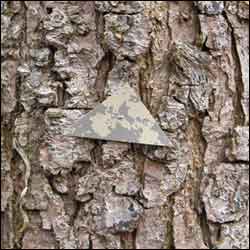What the eye doesn’t see …

An artificial moth on tree bark.
The first experimental evidence that birds can be deceived by camouflage in the same way that humans are deceived, is published today in Nature [3 March 2005].
The idea that bold contrasting colours help to break-up the body’s outline was rapidly adopted by many armies as long ago as the First World War. And in biology this idea of ‘disruptive colouration’ has long been used to explain how insects such as moths conceal themselves from predators, shaping the evolution of protective coloration in insects.
Innovative research from the University of Bristol provides the strongest evidence to date that disruptive patterns do indeed protect insects from detection by birds, the predator most likely to have shaped the evolution of protective coloration in insects.
Professor Innes Cuthill and his team pinned artificial ‘moths’ to trees in a field with a dead mealworm attached. The ’moths’ were triangular pieces of waterproof card with specific patterns printed on them. By varying the colours, size and location of patterns on the moths the team were able to mimic real tree characteristics and identify which pattern combinations were the most successful.
Professor Innes Cuthill said: “The rate at which mealworms were eaten by birds gives a measure of how effective each combination was at preventing detection by a predator. Combinations that gave a better disguise took longer to be seen, and it therefore took longer for the mealworms to be eaten.”
This research provides the first evidence that patterns which deceive humans operate in a similar way to those in non-human predators such as birds.
Media Contact
More Information:
http://www.bristol.ac.ukAll latest news from the category: Life Sciences and Chemistry
Articles and reports from the Life Sciences and chemistry area deal with applied and basic research into modern biology, chemistry and human medicine.
Valuable information can be found on a range of life sciences fields including bacteriology, biochemistry, bionics, bioinformatics, biophysics, biotechnology, genetics, geobotany, human biology, marine biology, microbiology, molecular biology, cellular biology, zoology, bioinorganic chemistry, microchemistry and environmental chemistry.
Newest articles

Properties of new materials for microchips
… can now be measured well. Reseachers of Delft University of Technology demonstrated measuring performance properties of ultrathin silicon membranes. Making ever smaller and more powerful chips requires new ultrathin…

Floating solar’s potential
… to support sustainable development by addressing climate, water, and energy goals holistically. A new study published this week in Nature Energy raises the potential for floating solar photovoltaics (FPV)…

Skyrmions move at record speeds
… a step towards the computing of the future. An international research team led by scientists from the CNRS1 has discovered that the magnetic nanobubbles2 known as skyrmions can be…





















